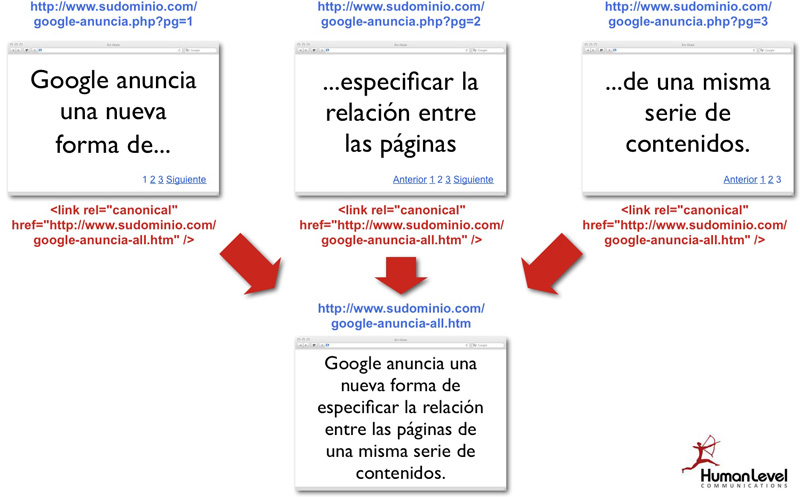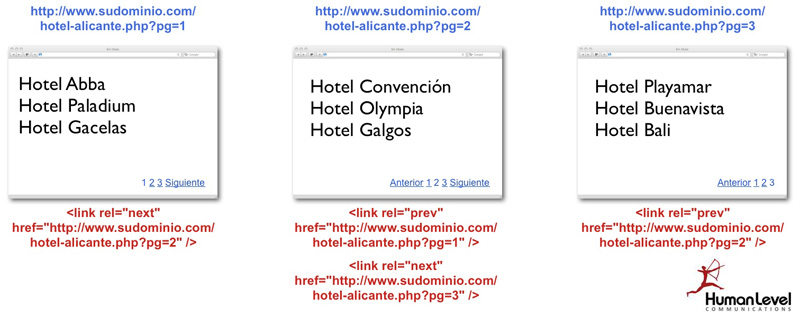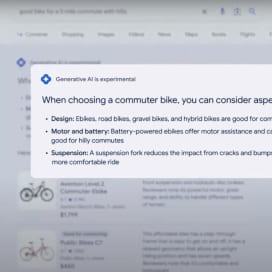Written by Fernando Maciá
The presentation of content on a series of different pages frequently occurs on Web sites when it is impossible to present all the information on a single page: for example, in long articles that are subdivided into several pages or, more frequently, in product listings.
Until now, this situation posed numerous challenges due to the difficulty of including unique titles and description goals for each of the pages of the series, as well as the distribution of popularity on each of the pages. Very often, Google only indexed the first page or pages of the series, which prevented you from being able to access, for example, product sheets from the links on the last pages of the series.
Solutions applied to date
One of the ways in which search engine positioning consultants had attacked this situation was to include a meta ROBOTS with the instruction “NOINDEX, FOLLOW” in the section <head> from the second page of the series. With the ROBOTS goal configured in this way, what we were trying to achieve was:
- That Google would index the first page of the series and display it in its results for relevant searches.
- That Google would not see the following pages of the series -usually with the same title and meta description as the first one- as duplicate content of the first one. By including “NOINDEX”, these pages should not be indexed.
- That Google would follow the links on each of the pages of the series to the product detail pages. By including “FOLLOW”, these links should be followed by Google to index these pages.
A second way was to include a rel=”canonical” pointing to the first page on each of the pages in the series so that Google would index only the first page as a result for the entire series.
Solutions to be applied from now on
Google recommends these options for paid content:
Paginated editorial content
Create a single page with all the content of the series, linked to a “See all” link on the first page of the series. In the search engine’s opinion, this page is the one that is likely to result in the best user experience, except when load time or some other problem prevents the presentation of all content on a single page or makes this presentation very unusable. In case you are able to implement this solution, then Google recommends adding rel=canonical on each and every page of the series pointing to the URL with the “See all” version. (Click on the image to see it full size)
Human Level Communications recommends implementing this solution for content such as news articles, reports or small listings spread over a few pages.
List of paginated results
Specify the relationship between the different pages of a series by adding rel=”next” and rel=”prev” in the <head> section of the corresponding pages.
That is, if we have a series of pages whose URLs are of the type:
- https://www.sudominio.com/productos?tipo=abc&page=1
- https://www.sudominio.com/productos?tipo=abc&page=2
- https://www.sudominio.com/productos?tipo=abc&page=3
- https://www.sudominio.com/productos?tipo=abc&page=4
On the first page, https://www.sudominio.com/productos?tipo=abc&page=1, we will include in the section <head> the following:
<link rel="next" href="https://www.sudominio.com/productos?tipo=abc&page=2" />
In this case, we do not include any previous reference with rel=”prev” because it is the first page of the series.
On the second page, https://www.sudominio.com/productos?tipo=abc&page=2, we will include under the section <head> the following
<link rel="prev" href="https://www.sudominio.com/productos?tipo=abc&page=1" />
<link rel="next" href="https://www.sudominio.com/productos?tipo=abc&page=3" />
That is, the reference to both the page before page 2 and the following page.
On the third page, https://www.sudominio.com/productos?tipo=abc&page=3, we will include within the section <head> the following:
<link rel="prev" href="https://www.sudominio.com/productos?tipo=abc&page=2" />
<link rel="next" href="https://www.sudominio.com/productos?tipo=abc&page=4" />
That is, the reference to both the page before page 3 – page 2 – and the following page – page 4.
On page 4, which is the last page, https://www.sudominio.com/productos?tipo=abc&page=4, we will include in the section<head> the following:
<link rel="prev" href="https://www.sudominio.com/productos?tipo=abc&page=3" />
In this case, we do not include any previous reference with rel=”next” because it is the last page of the series (click on the image to see it full size).
Human Level Communications recommends implementing this solution for long product listings, hotel listings, restaurant listings, etc. that take up many pages.
To recap:
- The first page of the series only includes rel=”next” and not rel=”prev”.
- The last page of the series only includes rel=”prev” and not rel=”next”.
- The second to penultimate pages of the series include both rel=”prev” and rel=”next”.
- The URLs specified for rel=”prev” and rel=”next” can be either absolute or relative. We recommend, in the event that the content can be plagiarized, that the links be specified absolutely. They will continue to point to our pages unless the plagiarizer specifically edits them. If there is a base <link> on the page, the relative URLs are resolved according to the base URL specified by this tag.
- rel=”next” and rel=”prev” are only declared in the <head> section and NOT in the links of the <body> section of the page.
- rel=”next” and rel=”prev” are independent of rel=”canonical” and, in some cases, can work together without problems, for example, to eliminate indexing of URLs with session parameters.
- At the moment, rel=”next” and rel=prev” are hints for Google, not absolute directives.
- If not specified, Google will continue to crawl the series of pages as before, trying to identify the relationship between them and choosing in each case the most relevant one as a result.
- CAUTION: if the first page of the series is accessible via two different URLs, e.g. as the first page of the listing without pagination parameter –https://www.sudominio.com/productos?tipo=abc-and as the first listing page from all other pages including paging parameter –https://www.sudominio.com/productos?tipo=abc&page=1-, we must include a rel=”canonical” specifying the URL we want to index to avoid duplicate content: <link rel=”canonical” href=”https://www.sudominio.com/productos?tipo=abc&page=1″ />
In addition to everything recommended so far, Google published in December 2012 a very interesting video that clarifies some of the doubts that could arise regarding the implementation of its recommendations. The video is presented by Maile Ohye in a very didactic way and touches practically all the related points, although he leaves out some that we are going to discuss below.
More results on each page or more pages with fewer results on each page?
One of the first doubts that arise regarding paginated content is: are fewer pages with many results on each page better or many pages with fewer results? Obviously, pages with fewer results will take longer to download but pages with more results should, in principle, be more relevant because of their larger amount of text. So we will have to come up with a compromise solution.
Attention: Google recommends consistent URLs for all pages in the series.
One caution to keep in mind is that Google recommends that all pages in the series have a consistent URL in terms of parameters. This means, in the following series of pages:
- https://www.midominio.es/madrid/madrid/hoteles/hoteles-cuatro-estrellas/
- https://www.midominio.es/madrid/madrid/hoteles/hoteles-cuatro-estrellas.aspx?p=2
- https://www.midominio.es/madrid/madrid/hoteles/hoteles-cuatro-estrellas.aspx?p=3
- https://www.midominio.es/madrid/madrid/hoteles/hoteles-cuatro-estrellas.aspx?p=4
The last three pages have a consistent URL, where the parameter p=n indicates the order number the page occupies in the series. However, the first page does not have a URL consistent with the rest of the listing. This situation is quite common, as it is also common that once in the following pages of the series, the link pointing to the first one does include the page number parameter, generating duplicate content. To comply with Google’s guidelines, this first page should include a canonical with a URL consistent with the rest of the series, which in this case would be:
https://www.midominio.es/madrid/madrid/hoteles/hoteles-cuatro-estrellas.aspx?p=1
This would be the URL that would be indexed by Google and, at the same time, would avoid the duplicate content problem mentioned above.
Different titles on each page of the series, same title…?
Regarding titles and descriptions, Google indicates that the fact that they appear in the HTML recommendations in Google Webmaster Tools as duplicate titles and descriptions does not indicate that they are being detected as duplicate content but that, technically, titles and descriptions do indeed appear on more than one page. But this does not imply any downside risk or penalty risk.
Google’s recommendations in this regard are as follows:
- If the pages correspond to the development of the same content -for example, an article that is presented in three or four pages- then the recommendation would be to include the title of the article as the title on the first page of the series, and to include as titles on the following pages the headings corresponding to the sections developed on each page. And act likewise with the descriptions.
- If the pages correspond to a list of items sorted by some criteria – let’s say for example hotels sorted by price – then the upper and lower price limit included in each page of the series could be included in the price. For example, on page 1 we would have “Hotels in Alicante between 700 and 400€”, and on page 2 we would have “Hotels in Alicante between 380 and 120€”, etc. The maximum and minimum prices included in the title are the maximum and minimum prices of the hotels included in each page. This way we have different titles relevant to the content of each page.
- If the pages correspond to a list of items in no particular order, then Google recommends simply adding a page number at the end of the title: “Hoteles en Alicante en Guias 11811, página 1”, “Hoteles en Alicante en Guias 11811, página 2”.
- Or, simply leave the same title and description on all pages of the series and ignore the recommendations related to duplicate titles and descriptions in GWT.
Although it is tempting to programmatically include different titles targeting different keywords on each page of the series -for example, putting “Cheap hotels in Madrid” on the first page, “Cheap hotels in Madrid” on the second page, etc.- we believe that this option is risky. If Google requires a certain consistency in the URLs of the pages that make up the series, it is also possible that it expects this consistency in the title and description or, at least, a consistency between the title and the content. If there is no content that confirms the differentiation of the title, then it is probably not justified.
While finding distinct titles whose wording is consistent with the differential content of each page, as in cases 1 and 2, is fully justified, the maneuver of aggressively changing the title and description with undifferentiated content on each page of the series could at some point raise suspicions, so I would recommend making minimal changes, or simply adopting recommendation 3.
What if we use NOINDEX, FOLLOW?
Finally, I do not recommend using NOINDEX, FOLLOW in the rest of the pages of the series, nor a canonical in the rest of the pages of the series pointing to the URL of the first page. Although with the proposed recommendation Google will in most cases show the first page of the series as a result, for certain searches it may consider other pages of the series more relevant and may rank better.
Although, obviously, every SEO has his or her own little book. What is your opinion and what works for you?





